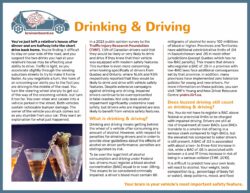Drinking & Driving
You’ve just left a relative’s house after dinner and are halfway into the short drive back home.
You’re finding it difficult to stay on your side of the road, and you suspect the two drinks you had at your relative’s house may be affecting your ability to drive. Traffic is light, so you accelerate slightly through the winding suburban streets to try to make it home faster. As you negotiate a turn, the honk of an oncoming car alerts you to the fact you are driving in the middle of the road. You turn the steering wheel sharply to get out of the way of the oncoming vehicle, but turn it too far. You over-steer and careen into a vehicle parked in the street. Both vehicles sustain noticeable bumper damage. The owner of the vehicle you struck comes out as you stumble from your car. They want an explanation for what just happened.
In a 2023 public opinion survey by the Traffic Injury Research Foundation (TIRF), 7.5% of Canadian drivers said that they would be likely or very likely to drink and drive if they knew that their vehicle was equipped with modern safety features. This number is even more concerning when looking specifically at drivers from Quebec and Ontario, where 16.6% and 9.5% respectively reported that they would be likely to drink and drive with vehicle safety features. Despite extensive campaigns against drinking and driving, impaired drivers continue to be overrepresented in fatal crashes. Not only does alcohol impairment significantly undermine road safety, but drivers who are impaired are less likely to benefit from vehicle safety features.
What is drinking & driving?
Drinking and driving means getting behind the wheel of a vehicle after consuming any amount of alcohol. However, with respect to penalties for drinking drivers and in order to provide clear guidelines about the effects of alcohol on driver performance, penalties are distinguished by risk.
To be over the legal limit of alcohol consumption and driving under Federal law, drivers must register a blood alcohol concentration (BAC) equal to or over .08mg. This means to be considered criminally impaired, a driver’s blood must contain 80 milligrams of alcohol for every 100 millilitres of blood or higher. Provinces and Territories have additional administrative limits of .04 in Saskatchewan and .05 in most other jurisdictions (except Quebec which has no low BAC penalty). This means that drivers who register a BAC of .05 in a province with low-BAC laws face additional consequences set by that province. In addition, many provinces have implemented zero tolerance policies for young and new drivers. For more information on these policies, you can visit TIRF’s Young and New Driver Resource Centre yndrc.tirf.ca.
Does buzzed driving still count as drinking & driving?
Yes. You do not have to register a BAC above federal or provincial limits to be charged with impaired driving. Drivers are still at risk of impairment at lower BACs. Low BACs translate to a smaller risk of being in a serious crash compared to high-BACs, but the elevated risk compared to sober drivers is still present. A BAC of .03 is associated with about a two- to three-fold increase in risk, while a BAC of .05 is associated with between a 6 and 17 times increase in risk of being in a serious collision (TIRF, 2010).
It is difficult to predict how your own body will react to alcohol. Your weight, body composition (e.g., percentage of body fat or water), sleep patterns, mood, and food consumption are all factors that affect your BAC. In general, it takes at least one and up to two hours for one drink to be processed through the body, so any alcohol consumed prior to driving may begin to take effect after you have already climbed in the driver’s seat. Given the range of different variables and conditions that can affect your level of impairment, your safest bet is to avoid driving altogether after drinking.
How does impaired driving affect traffic safety?
Drinking and driving has well-known effects on road safety. Alcohol-impaired drivers suffer from a variety of impairments in their performance: they commit sloppy driving errors, have significantly reduced situational awareness, and overall may be more likely to make unsafe decisions behind the wheel. The greater the level of impairment, the more likely the driver will be involved in a collision. Studies confirmed that driving with even a small amount of alcohol in your system greatly increases the risk of collision (Blomberg et al., 2009; Garrisson et al., 2022). Every drink that a person consumes has the ability to slow their reaction time, which can also be hindered by the other effects of alcohol including drowsiness, inattention, delayed information processing and even blurred vision. The inevitable results of alcohol-impaired driving are vehicle crashes and fatalities.
In 2021, 1 in 4 (26.5%) of fatal crashes in Canada involved a drinking driver (Barrett et al., 2023). The number of persons killed in crashes involving a drinking driver between 1996 and 2021 generally decreased from 875 to 391 fatalities (a 55% reduction) (Barrett et al., 2023).
How does drinking and driving affect safety features?
When polled in 2011, 7.5% of Canadian drivers reported that they would likely drink and drive if their vehicle was equipped with modern safety features. This is concerning because these features cannot be safely relied upon to compensate for the effects of alcohol.
One of the effects is delayed reaction time, which has sweeping effects for the functioning of all safety features. If drivers brake too late, safety features that help reduce stopping distance – including brake assist and electronic brake-force distribution – will have less time to work. If an impaired driver steers erratically, features that help to maintain stability and control including antilock braking systems (ABS) and electronic stability control (ESC) may be overwhelmed and fail to work at their best.
In addition to a delayed reaction time, alcohol has impairing effects on coordination and information processing. Drinking drivers are less able to respond to safety systems that warn them of impending collisions or accidental lane departures. Finally, features designed to improve visibility could have their benefits negated by a driver’s decreased ability to see clearly due to the effects of alcohol.
Drivers have an important role to play in the proper functioning of their safety systems, and alcohol-impairment can make fulfilling this role difficult or impossible. The good news is that by driving safely and attentively, drivers can accrue the maximum safety benefits that safety features have to offer.
Are Canadians concerned about drinking & driving?
Over the past 25 years, unprecedented gains have been made in reducing the number of alcohol-impaired drivers on the road and crashes involving drinking drivers. Ignition interlock devices reduce impaired driving by about 70% while they are installed and are an effective measure to ensure impaired drivers cannot drive their vehicles (CDC, 2022).
Public opinion polls have also consistently demonstrated widespread concern among Canadians about drinking drivers as a road safety issue. In TIRF’s 2023 survey, three quarters (75.5%) of Canadian drivers cited drinking and driving as an issue of concern on the public agenda (Barrett et al. 2023). While this statistic reveals that Canadian drivers still take drinking and driving very seriously, the number of people citing drinking drivers as a significant road safety issue seems to have stabilized and even decreased in recent years. While there are fluctuations over time in the percentage regarding drinking drivers as a serious problem, generally the percentage today is lower compared to most earlier years (Barrett et al., 2023). For example, in 2019 80.7% of Canadians cited drinking and driving as an issue of concern. The reasons behind this stabilization are still in need of thorough investigation; however it is nevertheless still clear that drinking drivers are a top concern among Canadians.
What are the laws in Canada against drinking & driving?
One of the reasons why impaired driving prevention campaigns are so effective was the introduction of highly visible enforcement efforts which raised awareness about the risks of alcohol impairment as a road safety issue, and to deter drivers from drinking and driving. Currently in Canada, there are both Federal and provincial/territorial laws in place.
The Federal Criminal Code of Canada (CCC) contains two laws that address drinking and driving. Section 320.14 prohibits the operation of a vehicle while impaired by drugs or alcohol, and Section 320.14(1)(b) prohibits the operation of a vehicle with a BAC of .08 or higher. It is also an offence under Section 320.27(2) to refuse to provide a breath sample if asked to do so by a police officer, or to cause an impaired driving crash involving serious injuries or death.
Provincial and territorial governments are responsible for driver licensing and have the authority to create administrative offences and impose penalties for drinking and driving through the provincial/ territorial Motor Vehicle Acts. Almost all jurisdictions in Canada have chosen to set a lower BAC that ranges from .04 to .05. This means that provinces/territories are able to impose driver licence suspensions and other penalties on drivers with a BAC that is below the criminal limit of .08. In addition to any criminal penalties imposed by the Courts, penalties can also be imposed by the driver licensing agency in each province/territory. Penalties often include roadside licence suspension, administrative licence suspension, and other penalties that escalate with multiple offences.
How many drivers drink & drive?
When asked about driving after consuming any amount of alcohol in the past thirty days, 13% of Canadians admitted to doing this in 2023. In addition, 5.8% admitted to drinking and driving when they thought they were over the legal limit in the past 12 months (Barrett et al., 2023). In 2022, data from the TIRF USA Road Safety Monitor revealed 19.6% of drivers reported driving when they thought they were over the limit in the last 12 months and 9.7% of drivers reported driving impaired often or very often (Vanlaar et al., 2023).
Who is most likely to drink & drive?
Drinking drivers do share some common characteristics including the tendency to drink and drive, but this does not mean that these offenders are all the same. The reality is that some people drive after drinking infrequently, while others do it often; some are at a relatively low risk of causing a collision, while others are at a very high risk. Impaired drivers are one of the most heterogeneous offender populations in the justice system and they come from all walks of life.
The majority of impaired drivers are men, however the issue of female impaired drivers is increasingly a growing concern. Impaired drivers also represent different age groups, levels of education, and professional achievement. The socio-economic status and criminal activity of these offenders also vary greatly. The truth is that the problem has many different parts to it and includes many different segments of the population. As such, it is essential to have a broad range of strategies or countermeasures available to create a comprehensive approach to address the problem.
What effect does alcohol have on my ability to benefit from vehicle safety features?
Your ability to benefit from vehicle safety features is significantly reduced with every alcoholic drink consumed before driving. This is because in order to maximize the benefit of safety features drivers must interact appropriately with their vehicle; a task that alcohol-impairment renders virtually impossible. Interacting appropriately with your vehicle involves more than just providing timely and effective braking and steering commands (although this is certainly an important part). Appropriate interaction also requires that you are aware of your surroundings and notice changes in speed limits, monitor traffic behind you, keep an eye on traffic in front of you, and recognize potential hazards on or near the road. This kind of awareness is referred to as situational awareness. Combining situational awareness with driving skill is the best way to make sure your safety features provide you with maximum protection and security.
However, with every alcoholic drink, your ability to perform your crucial role as a driver diminishes. As your impairment increases, it becomes more difficult to retain the level of situational awareness necessary to prevent you or someone else from being involved in a collision. Common effects of impairment include disorganized thoughts, slower information processing, drowsiness, poor judgement, and perception deficits. These effects seriously undermine your awareness.
In addition to these effects, alcohol impairment also significantly reduces hand-eye and foot-eye coordination. Even if you do spot a hazard on the road, you are less able to safely avoid it by steering or braking.
Your vehicle safety features cannot perform at their best if you as the driver cannot perform at your best. No matter how advanced vehicle safety features are, they cannot replace you in any way. If you choose to drive after drinking alcohol, you run the risk of being unable to interact appropriately with your vehicle and its safety features.
A concerning 9% of Canadian drivers polled in 2016 reported they would likely drink and drive if their vehicle had safety features (Robertson, Meister, & Vanlaar, 2016). However, given the ways in which driver impairment also impairs the driver’s ability to benefit from safety features, drivers who drink and drive because they have safety features on their vehicle are actually less protected than sober drivers.
What safety features are directly affected by drinking & driving?
One of the effects of alcohol impairment is delayed reaction time, which has sweeping effects on the functioning of all safety features. If you brake too late, safety features that help you stop sooner – including brake assist and electronic brake-force distribution (EBFD) – have less time to work. If you steer erratically, safety features that help you maintain stability and control – including anti-lock braking systems (ABS) and electronic stability control (ESC) – may be overwhelmed and fail to work at their best.
In addition to a delayed reaction time, alcohol has impairing effects on coordination and information processing. You will be less able to respond to safety systems that warn you of impending collisions or accidental lane departures. Finally, the benefits of safety systems designed to improve visibility are negated by declines in your ability to see clearly due to the effects of alcohol.
Where can I find out more information on drinking and driving?
Drinking and driving has been the subject of extensive research and public awareness programs. As such, a wide variety of resources are readily available that aim to increase knowledge and awareness of the scope of the drinking and driving problem, both currently and historically. TIRF has been conducting research on the drinking and driving problem in Canada for more than six decades, and is a proven leader in the alcohol-impaired driving field. Every year, TIRF publishes a Road Safety Monitor (RSM) dedicated to gauging public attitudes towards drinking and driving. The RSM also measures the level of concern over drinking and driving, and the number of Canadian drivers who admit to driving after consuming alcohol. In addition to the RSM, TIRF maintains Canada’s National Fatality Database which reports on the alcohol-crash problem in Canada. TIRF has played a leading role in assessing the effectiveness of various countermeasures against drinking and driving, with a particular emphasis on administrative penalties, ignition interlocks, and remedial driver licensing programs. Finally, TIRF’s Sober Smart Driving program continues to inform drivers about the effects of alcohol, the magnitude of the drinking and driving problem in Canada, and the consequences of impaired driving. These reports and many others can be accessed via TIRF’s website, at tirf.ca and sobersmartdriving.tirf.ca.
TIRF has collaborated with other leaders in road safety to further address drinking and driving in Canada. Organizations like ArriveAlive www.arrivealive.org, Beer Canada beercanada.com have partnered with TIRF to develop and disseminate resources aimed at raising awareness of Canada’s drinking and driving problem. TIRF has also partnered with Diageo North America to establish the Impaired Driving Coalition of Canada (IDCC) which is comprised of 23 organizations committed to preventing impaired driving tirf.ca/ projects/idcc. In addition, Transport Canada www.tc.gc.ca and the Canadian Council of Motor Vehicle Administrators (CCMTA) www.ccmta.ca have partnered with TIRF in the past and produced a variety of publications and education tools available online.
In addition, NHTSA has conducted research for many years in the United States on the drinking and driving problem. NHTSA’s publications are available at www.nhtsa.gov.
Finally, public awareness campaigns like Mothers Against Drunk Driving www.madd.ca and Students Against Drunk Driving www.sadd.org have educational links available on their websites.
Visit brainonboard.ca/programresources/references for a full list of references.
Related Videos
Play Video



